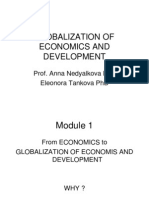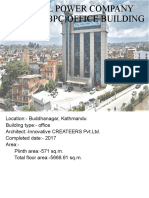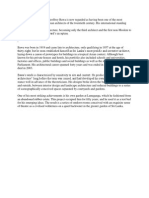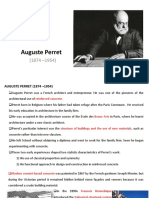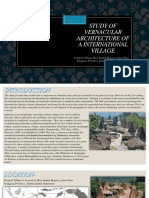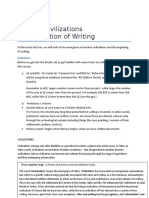Project REPORT ON Mud Architecture
Uploaded by
Janany SargunanCopyright:
Available Formats
Project REPORT ON Mud Architecture
Uploaded by
Janany SargunanOriginal Title
Copyright
Available Formats
Share this document
Did you find this document useful?
Is this content inappropriate?
Copyright:
Available Formats
Project REPORT ON Mud Architecture
Uploaded by
Janany SargunanCopyright:
Available Formats
Project REPORT ON MUD ARCHITECTURE Contents
Chapter-1 Chapter-2 Chapter-3 Chapter-4 Chapter-5 Chapter-6 Chapter-7 Chapter-8 Chapter-9 Chapter-10 Chapter-11 Chapter 1
Introduction History Mans oldest building material Mud housing technology Strength and Durability The context the region Applications Aesthetics Examples Case studies Conclusion Introduction
Mud has been the most essential of building materials since the dawn of the man. Nature set the example: termites built tower above ground and developed air circulation which prefigured modern ventilation processes; the potter wasp and its cousin the mud-mixer wasp used their mandible to knead and model vaults that were perfectly rounded, as if designed by architects.
From the earliest times men followed this example, he built dwellings, be they humble or elaborate, with materials that were closets at hand: out of fibers, leaves, stone or unbaked sun dried mud . Know how was acquired and passed down. But, with the onset of the industrial revolution, bricks of baked clay and mass produced materials such as cement, steel and glass gradually supplanted the basic elements of traditional construction. The development of transportation made it possible to bring building material from far away; while the use of modern components and specialized construction techniques brought about the loss of craftsmanship and art that had given each locale its sense of place. As the technical as well as the cultural roots of traditional architecture began to die out, the very shapes of buildings were transformed. But this trend cannot disguise the fact that unbaked mud is still the most viable building material for one third of the worlds population-predominantly the poor who remain on the side-lines of money economy that depends on manufactured materials. Furthermore, building with mud has become an important factor in planning new development.
Following the recent energy crises, technological progress has been made in certain countries, and the enthusiasm of architects and land developers has aided in the spread of these new techniques. Today we are able to choose between conventional international architecture and a more down to earth approach that combines reasonable cost with traditional cultural motifs in a modern way. But only people who live with the problem of hosing can make this choice, because they are the only ones who can create their way of life and decide how to project it through architecture. The day is coming when architecture will be for living, and not merely a spectator sport. Ruins, Restorations and Rushes Over one-third of the worlds population lives in mud houses, and this traditional construction method continues to thrive in most of the Third World. For modern Western technology has failed both financially and socially, to satisfy the increasing demand for cheap housing. In countries recently enriched by oil, these traditions have tended suddenly to disappear as happened in Europe during the 1930s and 1950s. They are nowadays- as then- replaced by architectural forms and technologies, which are considered to be indicative of social advancement, even though they are notoriously ill adapted to local climatic conditions. But the tide is changing, and since 1972 in the American Southwest groups of enthusiasts have brought about a revival of earth architecture for both communal and domestic uses. We are now, therefore, witnessing a series of simultaneous but discordant phenomena; in some regions of the world the architectural heritage is being abandoned or dying out, while in other countries earth buildings are now prized as important examples of universal wisdom, and are listed, restored and protected.
In addition, universities, academies and international institutions are attempting to forge a productive link between traditions and modernity. However, this enthusiasm sometimes leads to leads to the wildest parodies, committed by those hoping for quick profits. Some are not constructed in unbaked earth at all, and are perversions that betray the very spirit and nature of earth architecture, which, thanks to popular traditions, has always been able to suit an entire spectrum of differing circumstance Chapter 2 History
Ever since mankind first congregated in villages almost 10,000 years ago, unbaked mud has been one of the principal building materials used in every continent. Over one third of the worlds population still lives in mud houses today. In ancient times, unbaked mud was widely used in Mesopotamia and Egypt, while later on, Romans and then Muslims built in mud in Europe, Africa and the
middle east as did the peoples of the Indus civilizations ,Buddhist monks and Chinese emperors. During the middle ages, construction in unbaked mud was practiced not only in Europe, but in North America by the Indians, in Mexico by toltecs and the Aztecs, and in the Andes by the mochica.
The architectural heritage of India is not only enormously rich but also extremely varied. Manifestations of this unique heritage can be seen in all their diversity in different regions off country. The classical and beautiful architecture of India has been well documented and saved, but the traditions are threatened by the new demands for change and development. And now, since the early fifties , Indian architecture has witnessed four particularly eventful decades. The fifties and sixties what dominated by the modern moment and buy internationalism, a movement which to any extent is still going strong, although the terminology is changing. The first studies of traditional and vernacular architecture started emerging during the early seventies. Initially, they were not only found up on but even called dead ends. However, they gained respect during the eighties. The last decade is also significant for two other developments which have touched architectural not the only in India, but through out the world. First of all, the scope of historic preservation has widened... It does now include the urban fabric and other historic preservation. Architects and public planners are finding that task engaging and in some ways, rewarding. Archaeology has expanded its horizons into the mud is perhaps the most commonly used building material, particularly in ancient traditional communities. The universal acceptance of mud is clear. Mind architecture is enriched by the diversities of expressions, due to the use of various techniques. Its compatibility with the regional surroundings where it is found, along with the local social and cultural overtones has given it many distinctions. In spite of the constant nature of mind has a material, it is used as a widely accepted natural source of CONSTRUCTION. This variety can be observed an as much in the lush green mounting regions of the North, as in the deserts of the west, and in other parts of the country
To create a place to live, the interact with the environment while doing so and to give expression to their creative urges have been the most important of all human activities. The many fest form of a habitat expressed these ideas one and can be related to the cultural values and aspirations of a people. It is useful to examine a habitat in a specific space time context. The idea here is not to pass judgment on the status of civilization, but to understand a way of life. In spite of this Resource constraints and environmental problems, people build beautiful places. Even in situations where meagerness is a reality and the philosophy relationship with architecture. When people build, they create a habitat where the generative forces are, culture and context. While a culture is the sum total of human understanding, venues and accomplishments, context the represents the constraints and potential that the physical environment has to offer. These includes and the limitations and restrictions with which man has to live., indeed, a traditional habitat today is not the result off of one time effort what is the culmination of hundreds of years of understanding and response to a particular context. This articulation and consequence crystallization is the result of the negotiation between man and nature, between individual and the collective, between myth and science. Its strongly reflects amongst other things. That you opened idea of private and shared. The most dominant of all human instincts. The Skys The Limit Could the first-even skyscraper have been built of unbaked mud?for that was undoubtedly the material out of which the Tower of Babel was constructed in the 7th century BC in Babylon. Captain Robert Mignan recorded in 1829 that, The remains of the Tower of Babel are composed of kiln-burnt and sun-dried bricks, rising irregularly to the height of 139 feet. it is estimated that its seventh level once topped a height of 90 meters, and a number of other towns in ancient Mesopotamia contained vast, tiered towers or ziggurates, which were frequently about 40 to 50 meters high. These building traditions have been handled down through many centuries, and people still continue to use for the construction of towering edifices. Castle (kasbahs) and fortified villages (ksars) of the pre-Saharan valleys of Morocco, often rise to four storeys, as do villages of North American Indians such as that at Taos. the lofty minarets of mosques in Africa and the Middle East seem to defy gravity. But the city of Shibam in South Yemen is surely more amazing than all of these, and is often nicknamed Manhattan of the Dessert because its 500 buildings resembles a forest of skyscrapers, many of them rising to eight levels and standing 30 meters high. Although this building technique is part of very ancient tradition in the Yemen, half the buildings in Shibam have been erected during this century, providing that the custom thrives and can be readily adapted to suit the needs of contemporary city life.
Sensuality Building in mud seems to provide a particularly physical creative urge in its craftsmen. The fertility of soil itself perhaps inspires pleasure by naturally forming voluptuous curves, which the maker caresses as he works. Architecture is therefore the expression of profound impulses as well as producing images of physical and muddy pleasure. This immediacy and urgency invests domestic and communal spaces with a powerful erotic dimension, radiant with the joy of creation. A fine example is in Mali, where mud architecture surpasses the technical constraints of building, reflecting a delight in working this most basic raw material. Men and women translate this creative drive into a language which is all the more vital and elemental since it is perpetually in a state of flux and rebirth; the form of sculptural vocabulary are remodeled, reinterpreted and revitalized each year after the rainy season in a festival ritual. This mode of production involves a direct relationship with the material since it requires neither the use of complex instruments nor academic or technological knowledge. Instead, it demands only the desire of mud architect to participate in the traditions of the society and their eternal renewal, in harmony with the cultural heritage and the spirit of place.
MANS OLDEST BUILDING MATERIAL, MUD
Chapter -3
Mans oldest building material
In order to discover the origins of building in unbaked mud, we must look back some 10,000 years to the near east, where men first assembled in villages. The earliest of these appears to have been Jericho. Like Jericho, the famous city of Babylon was built in raw mud, as was the monument which dominated its heart some 27 centuries ago: the tower of Babel. Since that time the practice of building in unbaked mud has remained widespread in most countries of the world. Nowadays, at least a third of the worlds population still lives in houses of mud, benefiting from the efforts of countless generations of urban or rural peoples who, constantly assimilating, reinventing, and improving these building techniques, handed their knowledge on to their successors. Mud construction has passed the test of time, proving its merits and adaptability to the most diverse cultures, geographical conditions and climates. Examples of mud architecture are to be found in every continent: not only in the form of historical and archaeological remains but also, and above all, in the innumerable towns and villages where the secular heritage, enriched by exchanges between the most varied civilizations, is perpetuated daily. Recent
developments such as the energy crisis seem to invite us to continue this vital cycle of renewal of mud architecture. Dwelling forms and building methods which I use to make these forms are rich expirations of creative instincts. The results are not only aesthetically appealing, but also function and a satisfactory. Traditional architecture is an important area of study where one can reflect more directly to the form that determining forces. Quite often they are free from external influences and cleaches , and therefore true in expression. When people build for themselves working under a different constraints and restrictive local conditions, they respond directly to the situations as they find them , and achieve rich and expressive forms The direction as soft approach leads to let nature and contextual order which eliminates superficially . This approach is not restricted to the house from alone , but permiates each and every element of the living environment, from a house to an entire settlement . Like many other ancient cultures , architecture in India also came out into two distinct directions. White religious and royal architecture maintained a certain degree of formality and for load a classical tradition , secular architecture retained regional and vernacular properties . House is off higher costs assimilated features of both the formal and traditional architecture.
You might also like
- Improving Interchanges: Toward Better Multimodal Railway Hubs in the People's Republic of ChinaFrom EverandImproving Interchanges: Toward Better Multimodal Railway Hubs in the People's Republic of ChinaNo ratings yet
- Globalization of Economics and Development Globalizationof Economics and Development100% (1)Globalization of Economics and Development Globalizationof Economics and Development63 pages
- Pioneers in Planning Theories - HilberseimerNo ratings yetPioneers in Planning Theories - Hilberseimer2 pages
- Butwal Power Company Limited (BPC) Office BuildingNo ratings yetButwal Power Company Limited (BPC) Office Building13 pages
- Building Science and Energy ConservationNo ratings yetBuilding Science and Energy Conservation7 pages
- Methodical Approach To Repair BuildingsNo ratings yetMethodical Approach To Repair Buildings12 pages
- Case Study of "Patalkot": Human Settlements - Ar-508No ratings yetCase Study of "Patalkot": Human Settlements - Ar-50814 pages
- Matka Chowk - Traffic and Transportation - Sana Sawhney and Siddharth MahajanNo ratings yetMatka Chowk - Traffic and Transportation - Sana Sawhney and Siddharth Mahajan5 pages
- Tagore Memorial Hall: Pedestrian Island: SidewalksNo ratings yetTagore Memorial Hall: Pedestrian Island: Sidewalks12 pages
- The Energy Research Institute: Jatin Hukkeri Sirisha Madhumitha Srinivasan Sarvesh SrinivasanNo ratings yetThe Energy Research Institute: Jatin Hukkeri Sirisha Madhumitha Srinivasan Sarvesh Srinivasan20 pages
- Unit-4 (Dulal Mukherjee, Chandavarkar, Thacker Et Al)No ratings yetUnit-4 (Dulal Mukherjee, Chandavarkar, Thacker Et Al)21 pages
- Charles Correa: History & Theory of Architecture - IiNo ratings yetCharles Correa: History & Theory of Architecture - Ii29 pages
- Passive Strategies For Indoor Thermal Comfort in Warm Humid ClimateNo ratings yetPassive Strategies For Indoor Thermal Comfort in Warm Humid Climate10 pages
- Architectural Conservation Elective-Iv: Module-II: Traditional Building ConstructionNo ratings yetArchitectural Conservation Elective-Iv: Module-II: Traditional Building Construction11 pages
- Govardhan Eco Village: A Green Construction JourneyNo ratings yetGovardhan Eco Village: A Green Construction Journey7 pages
- Basement Constructio N and Methordolo GYNo ratings yetBasement Constructio N and Methordolo GY10 pages
- Microsoft Office Campus - Bangalore: A Project ReportNo ratings yetMicrosoft Office Campus - Bangalore: A Project Report6 pages
- Study of Vernacular Architecture of A International VillageNo ratings yetStudy of Vernacular Architecture of A International Village11 pages
- Landscape Architects: Fletcher Steele Kishore D PradhanNo ratings yetLandscape Architects: Fletcher Steele Kishore D Pradhan19 pages
- Adaptive Reuse of Farah Bakhsh Palace inNo ratings yetAdaptive Reuse of Farah Bakhsh Palace in86 pages
- Doosan Electric Reach Truck Br14jw 5 Br16jw 5 Part Book Sb1117e10No ratings yetDoosan Electric Reach Truck Br14jw 5 Br16jw 5 Part Book Sb1117e1022 pages
- Unpopular Essays Introduction, Summary and Critical Stance79% (14)Unpopular Essays Introduction, Summary and Critical Stance3 pages
- World Civilizations: The Global Experience, Volume 1 7th Edition, (Ebook PDF) 2024 scribd download100% (4)World Civilizations: The Global Experience, Volume 1 7th Edition, (Ebook PDF) 2024 scribd download55 pages
- The Human Journey - Achieving True Adulthood Through Wilderness Rites of PassageNo ratings yetThe Human Journey - Achieving True Adulthood Through Wilderness Rites of Passage18 pages
- Impact of Islamic Civilization On West PDFNo ratings yetImpact of Islamic Civilization On West PDF19 pages
- Group 1 General Concepts and Historical Events in STSNo ratings yetGroup 1 General Concepts and Historical Events in STS25 pages
- Soc Sci 2 Asian History and Civilization Syllabus100% (1)Soc Sci 2 Asian History and Civilization Syllabus6 pages
- 1177 BC: The Year Civilization Collapsed. by Eric H. Cline. New Jersey: PrincetonNo ratings yet1177 BC: The Year Civilization Collapsed. by Eric H. Cline. New Jersey: Princeton5 pages
- Social Science Class 6 Chapter 6 - The Beginnings of Indian Civilisation PDFNo ratings yetSocial Science Class 6 Chapter 6 - The Beginnings of Indian Civilisation PDF4 pages
- #2-Crash Course World History The Indus Valley CivilizationNo ratings yet#2-Crash Course World History The Indus Valley Civilization2 pages
- Mitsubishi Forklift Fgc70k Stc Service ManualNo ratings yetMitsubishi Forklift Fgc70k Stc Service Manual25 pages
- m3 Hittites Religion Women and Temple ProstitutesNo ratings yetm3 Hittites Religion Women and Temple Prostitutes7 pages
- In Some Sense: Eduardo Viveiros de CastroNo ratings yetIn Some Sense: Eduardo Viveiros de Castro17 pages
- Ancient Civilization and The Emergence of WritingNo ratings yetAncient Civilization and The Emergence of Writing12 pages
- Improving Interchanges: Toward Better Multimodal Railway Hubs in the People's Republic of ChinaFrom EverandImproving Interchanges: Toward Better Multimodal Railway Hubs in the People's Republic of China
- Entourage 5th Edition: A Tracing File and Color SourcebookFrom EverandEntourage 5th Edition: A Tracing File and Color Sourcebook
- Globalization of Economics and Development Globalizationof Economics and DevelopmentGlobalization of Economics and Development Globalizationof Economics and Development
- Butwal Power Company Limited (BPC) Office BuildingButwal Power Company Limited (BPC) Office Building
- Case Study of "Patalkot": Human Settlements - Ar-508Case Study of "Patalkot": Human Settlements - Ar-508
- Matka Chowk - Traffic and Transportation - Sana Sawhney and Siddharth MahajanMatka Chowk - Traffic and Transportation - Sana Sawhney and Siddharth Mahajan
- Tagore Memorial Hall: Pedestrian Island: SidewalksTagore Memorial Hall: Pedestrian Island: Sidewalks
- The Energy Research Institute: Jatin Hukkeri Sirisha Madhumitha Srinivasan Sarvesh SrinivasanThe Energy Research Institute: Jatin Hukkeri Sirisha Madhumitha Srinivasan Sarvesh Srinivasan
- Unit-4 (Dulal Mukherjee, Chandavarkar, Thacker Et Al)Unit-4 (Dulal Mukherjee, Chandavarkar, Thacker Et Al)
- Charles Correa: History & Theory of Architecture - IiCharles Correa: History & Theory of Architecture - Ii
- Passive Strategies For Indoor Thermal Comfort in Warm Humid ClimatePassive Strategies For Indoor Thermal Comfort in Warm Humid Climate
- Architectural Conservation Elective-Iv: Module-II: Traditional Building ConstructionArchitectural Conservation Elective-Iv: Module-II: Traditional Building Construction
- Govardhan Eco Village: A Green Construction JourneyGovardhan Eco Village: A Green Construction Journey
- Microsoft Office Campus - Bangalore: A Project ReportMicrosoft Office Campus - Bangalore: A Project Report
- Study of Vernacular Architecture of A International VillageStudy of Vernacular Architecture of A International Village
- Landscape Architects: Fletcher Steele Kishore D PradhanLandscape Architects: Fletcher Steele Kishore D Pradhan
- Doosan Electric Reach Truck Br14jw 5 Br16jw 5 Part Book Sb1117e10Doosan Electric Reach Truck Br14jw 5 Br16jw 5 Part Book Sb1117e10
- Unpopular Essays Introduction, Summary and Critical StanceUnpopular Essays Introduction, Summary and Critical Stance
- World Civilizations: The Global Experience, Volume 1 7th Edition, (Ebook PDF) 2024 scribd downloadWorld Civilizations: The Global Experience, Volume 1 7th Edition, (Ebook PDF) 2024 scribd download
- The Human Journey - Achieving True Adulthood Through Wilderness Rites of PassageThe Human Journey - Achieving True Adulthood Through Wilderness Rites of Passage
- Group 1 General Concepts and Historical Events in STSGroup 1 General Concepts and Historical Events in STS
- 1177 BC: The Year Civilization Collapsed. by Eric H. Cline. New Jersey: Princeton1177 BC: The Year Civilization Collapsed. by Eric H. Cline. New Jersey: Princeton
- Social Science Class 6 Chapter 6 - The Beginnings of Indian Civilisation PDFSocial Science Class 6 Chapter 6 - The Beginnings of Indian Civilisation PDF
- #2-Crash Course World History The Indus Valley Civilization#2-Crash Course World History The Indus Valley Civilization





